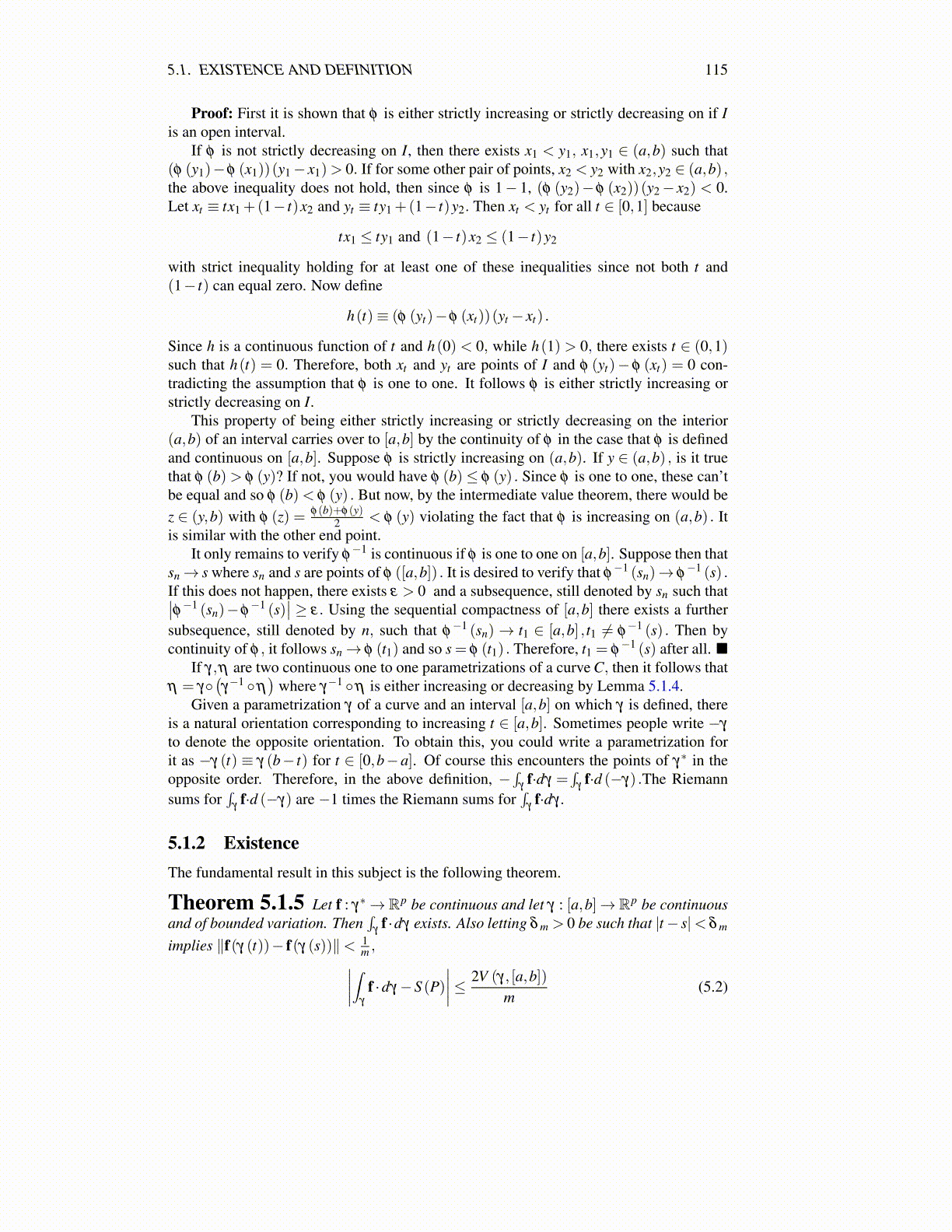
5.1. EXISTENCE AND DEFINITION 115
Proof: First it is shown that φ is either strictly increasing or strictly decreasing on if Iis an open interval.
If φ is not strictly decreasing on I, then there exists x1 < y1, x1,y1 ∈ (a,b) such that(φ (y1)−φ (x1))(y1− x1)> 0. If for some other pair of points, x2 < y2 with x2,y2 ∈ (a,b) ,the above inequality does not hold, then since φ is 1− 1, (φ (y2)−φ (x2))(y2− x2) < 0.Let xt ≡ tx1 +(1− t)x2 and yt ≡ ty1 +(1− t)y2. Then xt < yt for all t ∈ [0,1] because
tx1 ≤ ty1 and (1− t)x2 ≤ (1− t)y2
with strict inequality holding for at least one of these inequalities since not both t and(1− t) can equal zero. Now define
h(t)≡ (φ (yt)−φ (xt))(yt − xt) .
Since h is a continuous function of t and h(0) < 0, while h(1) > 0, there exists t ∈ (0,1)such that h(t) = 0. Therefore, both xt and yt are points of I and φ (yt)− φ (xt) = 0 con-tradicting the assumption that φ is one to one. It follows φ is either strictly increasing orstrictly decreasing on I.
This property of being either strictly increasing or strictly decreasing on the interior(a,b) of an interval carries over to [a,b] by the continuity of φ in the case that φ is definedand continuous on [a,b]. Suppose φ is strictly increasing on (a,b). If y ∈ (a,b) , is it truethat φ (b)> φ (y)? If not, you would have φ (b)≤ φ (y) . Since φ is one to one, these can’tbe equal and so φ (b)< φ (y) . But now, by the intermediate value theorem, there would bez ∈ (y,b) with φ (z) = φ(b)+φ(y)
2 < φ (y) violating the fact that φ is increasing on (a,b) . Itis similar with the other end point.
It only remains to verify φ−1 is continuous if φ is one to one on [a,b]. Suppose then that
sn→ s where sn and s are points of φ ([a,b]) . It is desired to verify that φ−1 (sn)→ φ
−1 (s) .If this does not happen, there exists ε > 0 and a subsequence, still denoted by sn such that∣∣φ−1 (sn)−φ
−1 (s)∣∣ ≥ ε. Using the sequential compactness of [a,b] there exists a further
subsequence, still denoted by n, such that φ−1 (sn)→ t1 ∈ [a,b] , t1 ̸= φ
−1 (s) . Then bycontinuity of φ , it follows sn→ φ (t1) and so s = φ (t1) . Therefore, t1 = φ
−1 (s) after all. ■If γ,η are two continuous one to one parametrizations of a curve C, then it follows that
η = γ◦(γ−1 ◦η
)where γ−1 ◦η is either increasing or decreasing by Lemma 5.1.4.
Given a parametrization γ of a curve and an interval [a,b] on which γ is defined, thereis a natural orientation corresponding to increasing t ∈ [a,b]. Sometimes people write −γ
to denote the opposite orientation. To obtain this, you could write a parametrization forit as −γ (t) ≡ γ (b− t) for t ∈ [0,b−a]. Of course this encounters the points of γ∗ in theopposite order. Therefore, in the above definition, −
∫γ
f·dγ =∫
γf·d (−γ) .The Riemann
sums for∫
γf·d (−γ) are −1 times the Riemann sums for
∫γ
f·dγ .
5.1.2 ExistenceThe fundamental result in this subject is the following theorem.
Theorem 5.1.5 Let f : γ∗→ Rp be continuous and let γ : [a,b]→ Rp be continuousand of bounded variation. Then
∫γ
f ·dγ exists. Also letting δ m > 0 be such that |t− s|< δ m
implies ∥f(γ (t))− f(γ (s))∥< 1m ,∣∣∣∣∫γ
f ·dγ−S (P)∣∣∣∣≤ 2V (γ, [a,b])
m(5.2)